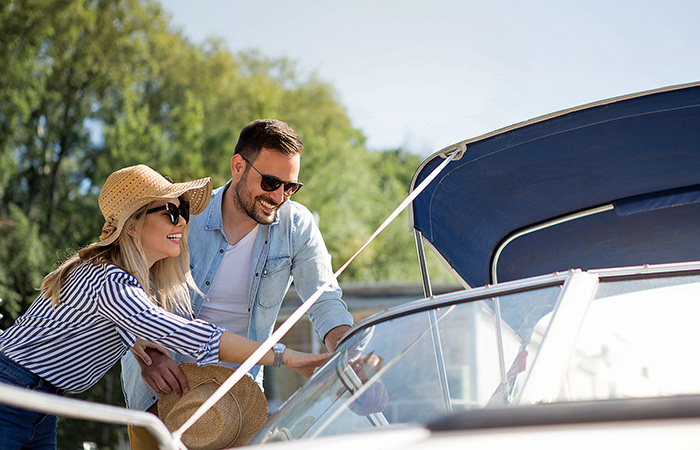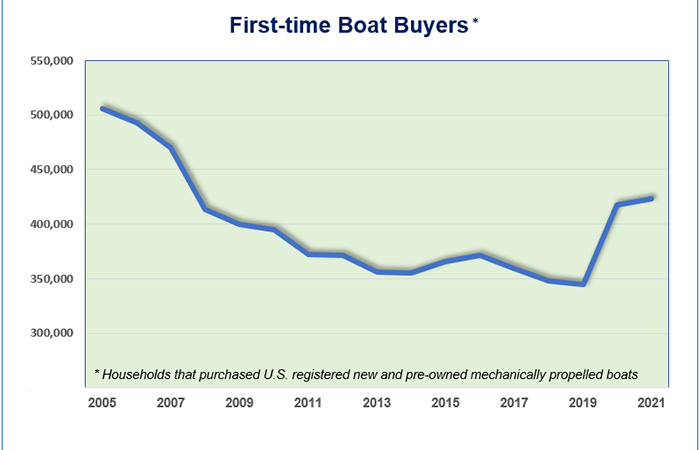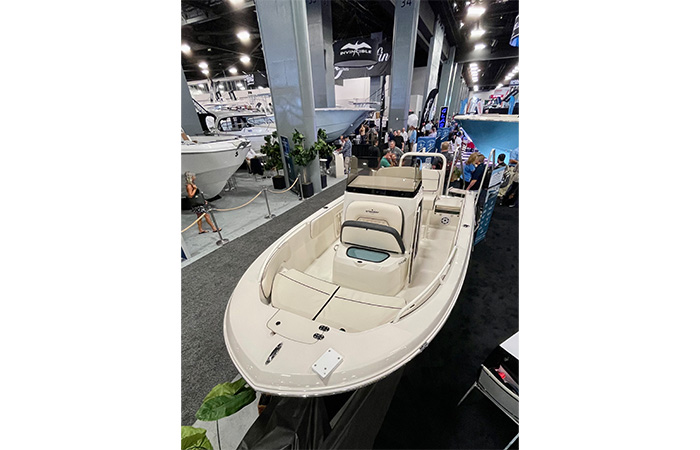Advertisement
A convergence of factors made the last few years a crazy time to buy or sell a boat. Here’s what happened – and what to know about today’s listings.

Photo: Getty
If you tried to buy a boat during the pandemic, you dove into a new type of retail environment – the quarantine market – featuring overwhelming demand, multiyear waitlists, soaring prices, and strong competition from other shoppers. Amid lockdowns, social distancing measures, travel restrictions, and canceled vacations, Americans turned to the water in droves. In 2020, boat sales skyrocketed to a 13-year high, reaching levels not seen since before the Great Recession of 2007 to 2009, according to data from the National Marine Manufacturers Association (NMMA), which represents U.S.-based boat, marine engine, and accessory manufacturers.
But before that happened, most boat manufacturers were expecting another spending pullback, as occurred after the 2008 economic crash, and decided to cut or curtail manufacturing just as demand was ramping up, according to business publications that report on the recreational boating industry. Safety measures to reduce worker exposure to the infectious Covid virus further slowed production lines, and global supply-chain issues made the situation worse.
“We saw a huge spike in demand,” said Nicole Schantz, vice president of OEM & strategic partnerships for Trader Interactive, which includes Boatline.com, an online marketplace that connects consumers with new and pre-owned boats for sale across the U.S.
For every new boat sold in America, more than three pre-owned vessels are sold in a typical year, according to NMMA data. In 2020, pre-owned boat sales exceeded 1 million units for the first time since 2006, and prices surged as used boat inventory shrank.
The X-factor fueling the unexpected run on recreational boats was the flood of first-time boat buyers, according to NMMA. Boat dealers recount pandemic stories of buyers who turned the budget for a canceled family vacation into the down payment on a new boat. Data shows about 420,000 first-time boat buyers entered the market in 2020, and again in 2021 – levels not seen since 2007. In fact, first-time boat buyers accounted for 34% of new boat sales in 2021.

The frenzy is fading
If the past few years have been an extraordinarily challenging time to boat shop, are buying conditions any better now that the pandemic no longer dominates our lives? Industry insiders say the advantage is shifting toward buyers, but slowly. Overall supply has caught up with demand, and the number of boat sales appear to be falling more in line with prepandemic levels.
For example, in 2022, new powerboat retail unit sales decreased 13% year-over-year according to NMMA. But compared with 2019 (the last “normal” year for the boat market), 2022 sales were 6% lower. Pre-owned boat data shows 2022 sales down 13% year-over-year, but up 3% from 2019.
Courtney Chalmers, vice president of marketing for Boats Group, which owns several online marketplaces for both new and pre-owned vessels (including Boat Trader, YachtWorld, and Boats.com), is seeing similar trends. She attributes the dips in demand to a boat market that’s “normalizing” toward prepandemic levels combined with a rise in interest rates. Final sales figures for 2023 won’t be known for some time, but during the first six months of this year, new and used boat sales were tracking roughly the same as the first half of pre-pandemic 2019, and powerboat sales were down 4% compared to 2022.
Schantz agrees. “Around the middle of 2022, we began slowly seeing the trends normalizing to prepandemic levels. They’re still a bit higher than pre-pandemic, however, which confirms that America’s boating passion is still afloat.”
Now that there's more inventory available, there's also more room for discounting.

While it’s still a seller’s market, boat buyers have more negotiation power now than they’ve had during the last few years.
More boats, shorter waits
Buyers who purchased new boats in 2021 were facing two- or three-year waiting lists, but manufacturers have caught up to demand and “inventory availability has begun to stabilize,” says Chalmers.
“I think we’re going to continue to see a growth in listings coming online as inventory continues to ramp back up.”
Schantz is already seeing that. “We’ve seen a substantial increase in Boatline’s used boat listings. But we’re also seeing more leads from potential buyers.” In fact, inquiries for used boat listings are about five times higher than those for new boats. She surmises that’s because a lot of people who purchased boats during the Covid-fueled buying frenzy didn’t spend a lot of time researching options or had little choice. “They may be trading up or looking for the right lifestyle choice now that they know more. Many people didn’t know what they didn’t know or bought whatever they could get.”
JP Skov, executive director at Yacht Brokers Association of America and managing partner at Northstar Yacht Sales, based in Portsmouth, Rhode Island, also sees things on the pre-owned side starting to return to 2019 levels. However, he echoes that used-boat buyers may also end up waiting months to a year for some boat types, specifically noting high-horsepower models.
“As long as you’re below 300-hp for a single-engine boat, you’ll probably get it fairly quickly,” he says. “But if you’re looking for 300s or above, you could wait a couple of months easily for that motor.”
Ellen Bradley, senior vice president of marketing and communications for NMMA, advises new boat buyers, “There might be the odd waitlist, depending on the type of boat you’re looking for. But for the most part, those wait periods have stopped.”
Tip
Room to negotiate The pandemic and its ripple effects quickly turned boat buying into a sellers’ market. But while sales have decreased, pricing is a lagging indicator. According to NMMA data, the average retail price of a new outboard boat (including engine) increased 44% from 2019 to 2022, while pre-owned boats were up 28% over the same period.
While inflation has certainly contributed to higher new boat prices, Schantz says there remains continued demand for both new and used boats.
“While not as great as the last few years, boat prices remain higher than in pre-Covid years. But now that there’s more inventory available, there’s also more room for discounting.” She says that while it’s still a seller’s market, buyers have more negotiation power than they did.
Jack Ellis, managing director at Info-Link, a market research firm that tracks boat sales statistics in the U.S., cautions buyers that prices for new and used boats will not be returning to 2019 levels any time soon. However, he agrees there’s now more room for consumers to negotiate. “Things are definitely starting to cool off. No longer is the dealer expecting to get MSRP.”
He speculates that used boat prices should start to come down as supply and demand return to a more conventional balance.
Expert tips for selling a boat
- Put together a great ad. Schantz says the key is including great photos and a video, if possible. Also write a great description that engages the customer. “Don’t just include the spec info from the manufacturer. Help the potential buyer envision being on your boat.”
- Price it right. With changing prices, owners may be wondering what’s their boat worth today. Schantz advises doing your research and setting a realistic price. For boats valued over $75,000, Skov recommends engaging with a professional broker. Not only will they have a sense of the local market, but they’ll also have access to databases that list the actual sale price (not just the listing price).
- Manage your expectations. “Boats are very personal. I always say it’s like someone’s child,” says Skov. It can be hard to let your beloved boat go, especially for a price that seems low. If your boat has been sitting on the market, contact a broker who can act as a valuable sounding board.
- Sell for the right reasons. There are plenty of great reasons to sell a boat — upgrading, downsizing, lifestyle changes — but you may be out of luck if your goal is to make a quick profit. “Any used boat that’s kind of hanging around is either not as nice as it should be or the owner has put it on the market to capitalize on this pandemic market but, in reality, they’ve kind of missed the wave,” says Skov. — F.M.
Expert tips for buying a boat
- Know your intended use. Before beginning your search, Schantz suggests making a list of your boating needs. “Do you want to take out large groups? Go water skiing? Go fast? Toodle around the lake?” If you’re not sure where to start, Bradley recommends visiting discoverboating.com. The NMMA website has several tools including a boat-finder quiz that can help you narrow down boat types and explore brands.
- Set a realistic budget, says Schantz. “Make sure to figure in all costs” including surveys, registration, taxes, necessary repairs, and more. To help, visit BoatUS.com/Loans to access BoatU.S.’s handy boat loan calculator.
- Find a reputable dealer or broker. “There are certification and training programs for dealers and brokers,” says Chalmers. “Look for certified dealers through the Marine Retailers Association (MRAA) or Certified Professional Yacht Brokers (CPYB).”
- Research your boat options thoroughly, advises Schantz. Compare models. Make sure you have all the information possible before starting negotiations. Additionally, Bradley recommends attending boat shows. “They’re one of the best places to see all the new products, do some negotiating, and find some deals for the season.”
- Get a survey. BoatU.S. recommends hiring an accredited marine surveyor to perform a pre-purchase survey and sea trial on the boat you’re considering. This is the best way to discover any problems before it’s too late. Get recommendations for a reputable surveyor credentialed by NAMS or SAMS, and be sure your purchase agreement contains a clause that stipulates that your offer is contingent on a satisfactory survey.
- Know your financing options. There’s more than one way to apply for a boat loan. You can apply through a lending institution (like your bank or credit union), a dealer, or through a service company or finance broker. Coburn notes there are several advantages to financing your boat through a dealer, including access to “special finance programs on certain brands or models because of [the dealer’s] relationships with boat manufacturers.” — F.M.
Rates and requirements
For those looking to finance a boat, don’t expect a break on rates anytime soon.
“The prime rate is expected to remain elevated through 2024,” says Jim Coburn, owner of The Coburn Consulting Company and director and two-time past president at the National Marine Lenders Association (NMLA).
For some, it may be harder to get a loan amid tightening credit requirements, he adds. In a recent survey of members, about 40% of participating portfolio and service company lenders made criteria for loan approvals more stringent.
“Some portfolio lenders commented that they had not changed their lending policies but are now making fewer exceptions in the areas of loan-to-value ratios, collateral valuation, and/or liquidity requirements,” Coburn says.
Schantz adds that as of now, manufacturer prices aren’t coming down enough to make up for the interest rate increases.
All in all, if you missed out on the pandemic-fueled boat buying free-for-all (or chose to stay on the sidelines), there’s good news: Both the new and used markets are becoming more buyer-friendly and should at least offer a less stressful shopping experience. With improved selection, reduced waitlists, and the potential for price negotiation, you can take your time finding the right boat to get you on the water next spring.
Tip
What’s hot today
“Pontoons, ski-wakeboats, center-consoles, bow riders — those tend to be the favorite types, particularly on Boat Trader,” says Chalmers. “Boats under 35 feet have really been driving sales because they’re good boats for first-time buyers. Also, versatile boats tended to be the most popular. A ski-wakeboat can be used for taking the family out, a center-console can be good for fishing or tubing.”
“Industry-wide sales of aluminum-hulled boats, specifically pontoons, have increased 14% year over year in June” says Schantz. She’s seen the same trend mirrored in marketplace sales on boatline.com. “Pontoons offer comfort without compromising the kind of boating you want to do. They accommodate large groups and a variety of water hobbies,” she explains.
“The outboard segment is becoming a more popular vote overall,” says Bradley. “The technology in the engines today is not only more efficient and more sustainable, it’s also a lot easier to use and can provide a better experience.” — F.M.
